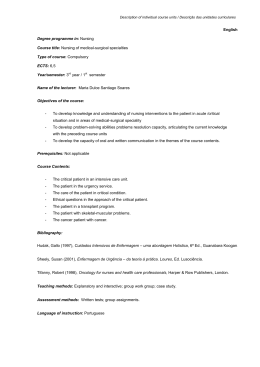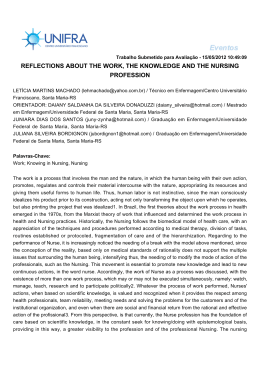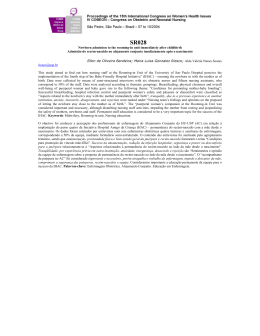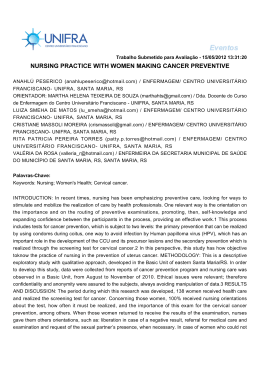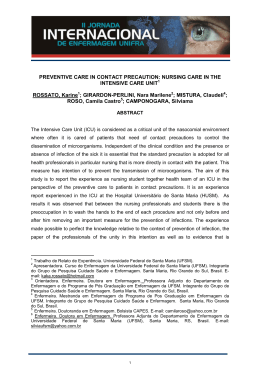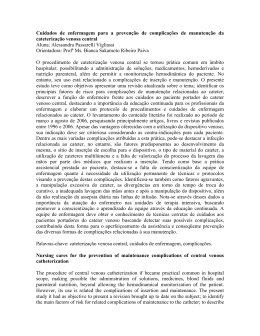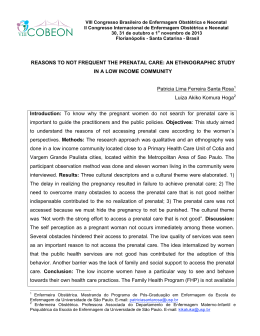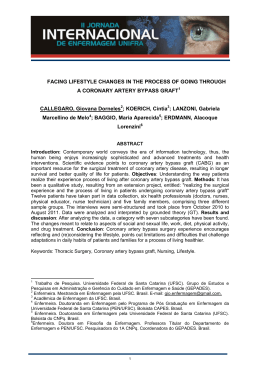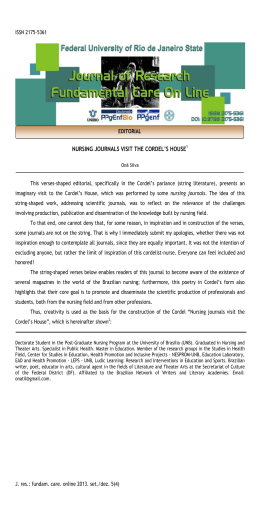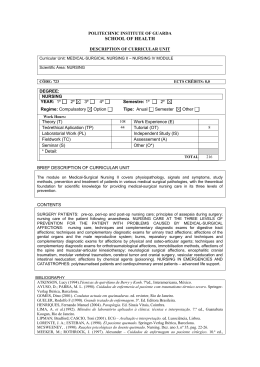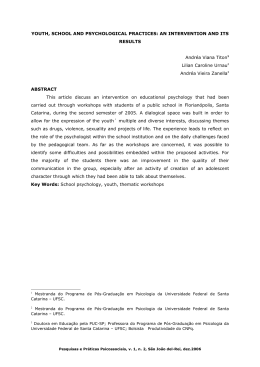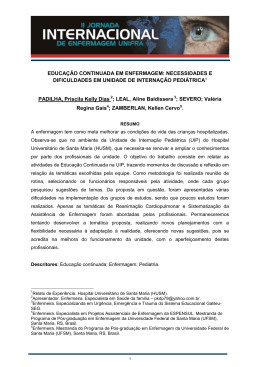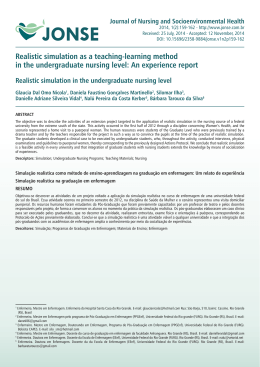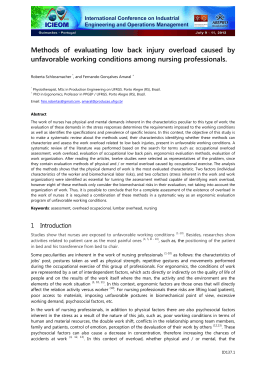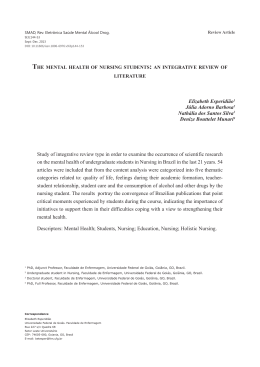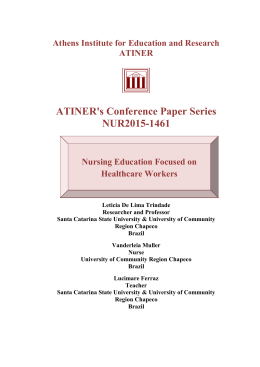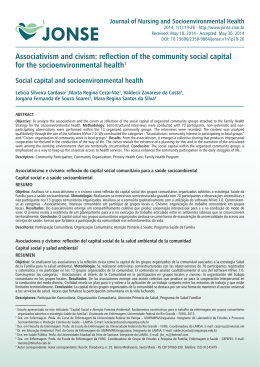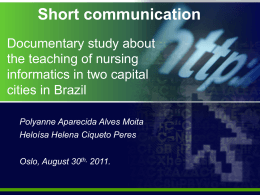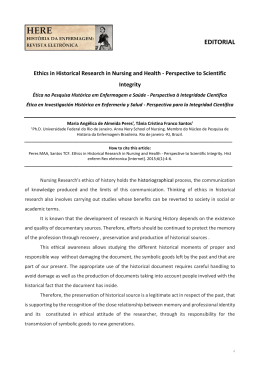Trabalho Submetido para Avaliação - 24/04/2012 23:32:24 SCIENTIFIC PRODUCTION OF NURSES ABOUT MYOCARDIAL REVASCULARIZATION CLAUDIA REGINA MALDANER ([email protected]) / Mestranda em Enfermagem do Programa de Pós-Graduação em Enfermagem (PPGENF) da UFSM. , Santa Maria-RS ORIENTADOR: BEUTER, MARGRID ([email protected]) / Doutora em Enfermagem. Professora Adjunta do Departamento de Enfermagem e do PPGEnf da UFSM/RS., Santa Maria-RS GIRARDON-PERLINI, NARA MARILENE OLIVEIRA ([email protected]) / Doutora em Enfermagem. Professora Adjunta do Departamento de Enfermagem e do PPGEnf da UFSM/RS., Santa Maria-RS TIMM, ARLETE MARIA BRENTANO ([email protected]) / Mestranda em Enfermagem do Programa de Pós-Graduação em Enfermagem (PPGENF) da UFSM. , Santa Maria-RS PAULETTO, MACILENE REGINA ([email protected]) / Mestranda em Enfermagem do Programa de Pós-Graduação em Enfermagem (PPGENF) da UFSM. , Santa Maria-RS MISTURA, CLAUDELÍ ([email protected]) / Mestranda em Enfermagem do Programa de PósGraduação em Enfermagem (PPGENF) da UFSM. , Santa Maria-RS SANTOS, NAIANA OLIVEIRA DOS ([email protected]) / Mestranda em Enfermagem do Programa de Pós-Graduação em Enfermagem (PPGENF) da UFSM. , Santa Maria-RS MATHIAS, CAROLINE VIEIRA ([email protected]) / Mestranda em Enfermagem do Programa de Pós-Graduação em Enfermagem (PPGENF) da UFSM. , Santa Maria-RS Palavras-Chave: NURSING; CARDIOLOGY; MYOCARDIAL REVASCULARIZATION. INTRODUCTION: The Coronary Artery Bypass Graft (CABG) consists of an arterial graft coronary that uses the saphenous vein from the patient himself with the aim of isolating the vessel clogged and, thus, restoring perfusion of coronary artery. This surgery, has the goal of preserving the myocardium (1). After surgery, the people must undergo a rehabilitation process, maintain healthy habits, make use of prescribed medications, among others. This process helps the person to achieve an acceptable quality of life with dignity, self-esteem and independence (2). The CABG appears as a large field for nurses,. The objective of this study was to identify main approaches discussed by the nurses in their scientific production related to CABG. METHODOLOGY: We conducted a literature review to answer the following question: what are the main topics discussed by the nurses in their scientific production in relation to coronary artery bypass grafting? The search was conducted in February 2012 in the databases Literatura Latino-Americana e do Caribe em Ciências da Saúde (LILACS) and BDENF (Base de Dados de Enfermagem), was used use of descriptor "Myocardial Revascularization" and as the word "Nursing ". Inclusion criteria were: articles written by nurses, credentials of the authors were observed, full articles on CABG, periodical on Portuguese, Spanish or English. The electronic searches allowed the location of 21 articles on LILACS and 16 in the BDENF. After applying the inclusion criteria, remain 10 articles in LILACS and 12 on BDENF. The number of articles has been reduced of 37 for 13, the articles repeated has been automatically discarded. RESULTS AND DISCUSSIONO: Of all the articles examined, only one was not Brazil (Colombia), 9 of the last five years, 8 articles used a quantitative approach, two quantitative and qualitative, and two were review of the literature. The articles were 10 different periodical, thus it is perceived that there was no predominance of a specific periodical. After perusal of these articles were identified that 4 about the demographic profile (age, gender, education, income, length of surgery, among others), and in one emotional aspects related to the profile of the subjects. Other articles about issues of self-care , membership or non-treatment and implications for nursing care with the profile. Two articles emphasized the health education theme, one about with the knowledge and learning needs related to surgery. Another article treated on the use of a protocol as a strategy of health education during nursing consultations. Nurses have an important role in health education with the revascularized patients and their families. The assistance can be focused on how to do dressings, administer medication, physiotherapy and other orientations, in order at recovery and troubleshooting (3). Three articles were about clinical aspects, such as complications and problems in post-operative and the other used an instrument in preoperatively. Three articles addressed the psychological aspects, emotional issues and feelings, one of which used a protocol to correlate anxiety with depression. Another article was about the social adjustment after revascularization with the return of individuals to their social activities. One study comparative between patients who underwent revascularization and valve replacement about powerlessness for many everyday situations and their psychosocial factors. In this sense, the nurse must provide a holistic care, emphasizing the emotional aspects, in order to minimize negative feelings and behavior for the recovery of the patient post-CABG (4). Presents also an article on the uniformization of concepts used by the multidisciplinary team in CABG as a way to facilitate good communication between all involved. CONCLUSION: The scientific production of nursing in the CABG is growing in recent years. There is research to address issues psychological and clinics, some with a focus on health education, already theme related to the integrated care in which nurse performing its role as promoter of this care, have not been contemplated. With this, are observed gaps on the publications addressing issues that bring contributions in this direction, concerning the role of active and participant nurse. It is understood that this may be contributing to the poor visibility of the nurse as a key member of the multidisciplinary team in CABG. REFERÊNCIAS: Galdeano LE. Rossi LA. Nobre LF. Ignácio DS. ; Diagnóstico de enfermagem de pacientes no período transoperatório de cirurgia cardíaca.; Rev Lat-american Enferm ; 11 (2); 199-206.; 2003. Smeltzer SC. Bare BG. ; Tratado de Enfermagem Médico Cirúrgica. ; Rio de Janeiro; Guanabara Koogan; 2005. Dantas RAS, Aguillar OM.; Problemas na recuperação de pacientes submetidos à cirurgia de revascularização do miocárdio: o acompanhamento pelo enfermeiro durante o primeiro mês após a alta hospitalar. ; Rev Latino-Am Enferm. ; 9 (6); 31-6.; 2001. Lima FET, Magalhães FJ, Silva DA, Barbosa IV, Melo EM, Araújo TL. ; Emotional alterations gifts in the patients Who underwent coronary artery bypass. ; Rev enferm UFPE On Line.; 4(2); 785-91. ; 2010.
Download
